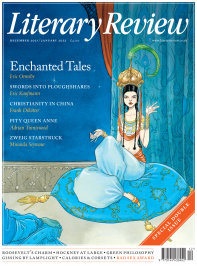Jeremy Noel–Tod
Dating Games
The Twentieth Century in Poetry
By Michael Hulse & Simon Rae (ed)
Ebury Press 880pp £25
In his 1908 ‘Lecture on Modern Poetry’, the modernist agitator, T E Hulme, described the relationship between poetry and prose as the origin of cliché: ‘One might say that images are born in poetry. They are used in prose, and finally die a long, lingering death in journalists’ English.’ The Twentieth Century in Poetry illustrates the process starkly. The first poem of the book, Thomas Hardy’s ‘The Darkling Thrush’ (dated ‘31 December 1900’), is a lament for the nineteenth century which anticipates the strangeness of the twentieth through bleakly vivid imagery (‘The tangled bine-stems scored the sky/Like strings of broken lyres’). Compare the melancholy poise of Hardy’s ‘good-night air’, though, with the breezy prose of his latest anthologisers:
[In 1901] Queen Victoria had died … bringing to an end the age to which she gave her name … as the more than middle-aged Prince of Wales mounted the throne after his marathon wait to succeed, his subjects hoped for a breath of fresh air. The great glacier of Victorian social attitudes had been showing cracks for some years.
And so it goes on, summarising a Whig interpretation of history since 1900 that veers unconsciously close to the regurgitated schoolboy causalities of 1066 and All That (‘Edward VII was quite old when he came to the throne, but this was only on account of Queen Victoria’). Worse still, poets

Sign Up to our newsletter
Receive free articles, highlights from the archive, news, details of prizes, and much more.@Lit_Review
Follow Literary Review on Twitter
Twitter Feed
It wasn’t until 1825 that Pepys’s diary became available for the first time. How it was eventually decrypted and published is a story of subterfuge and duplicity.
Kate Loveman tells the tale.
Kate Loveman - Publishing Pepys
Kate Loveman: Publishing Pepys
literaryreview.co.uk
Arthur Christopher Benson was a pillar of the Edwardian establishment. He was supremely well connected. As his newly published diaries reveal, he was also riotously indiscreet.
Piers Brendon compares Benson’s journals to others from the 20th century.
Piers Brendon - Land of Dopes & Tories
Piers Brendon: Land of Dopes & Tories - The Benson Diaries: Selections from the Diary of Arthur Christopher Benson by Eamon Duffy & Ronald Hyam (edd)
literaryreview.co.uk
Of the siblings Gwen and Augustus John, it is Augustus who has commanded most attention from collectors and connoisseurs.
Was he really the finer artist, asks Tanya Harrod, or is it time Gwen emerged from her brother’s shadow?
Tanya Harrod - Cut from the Same Canvas
Tanya Harrod: Cut from the Same Canvas - Artists, Siblings, Visionaries: The Lives and Loves of Gwen and Augustus John by Judith Mackrell
literaryreview.co.uk